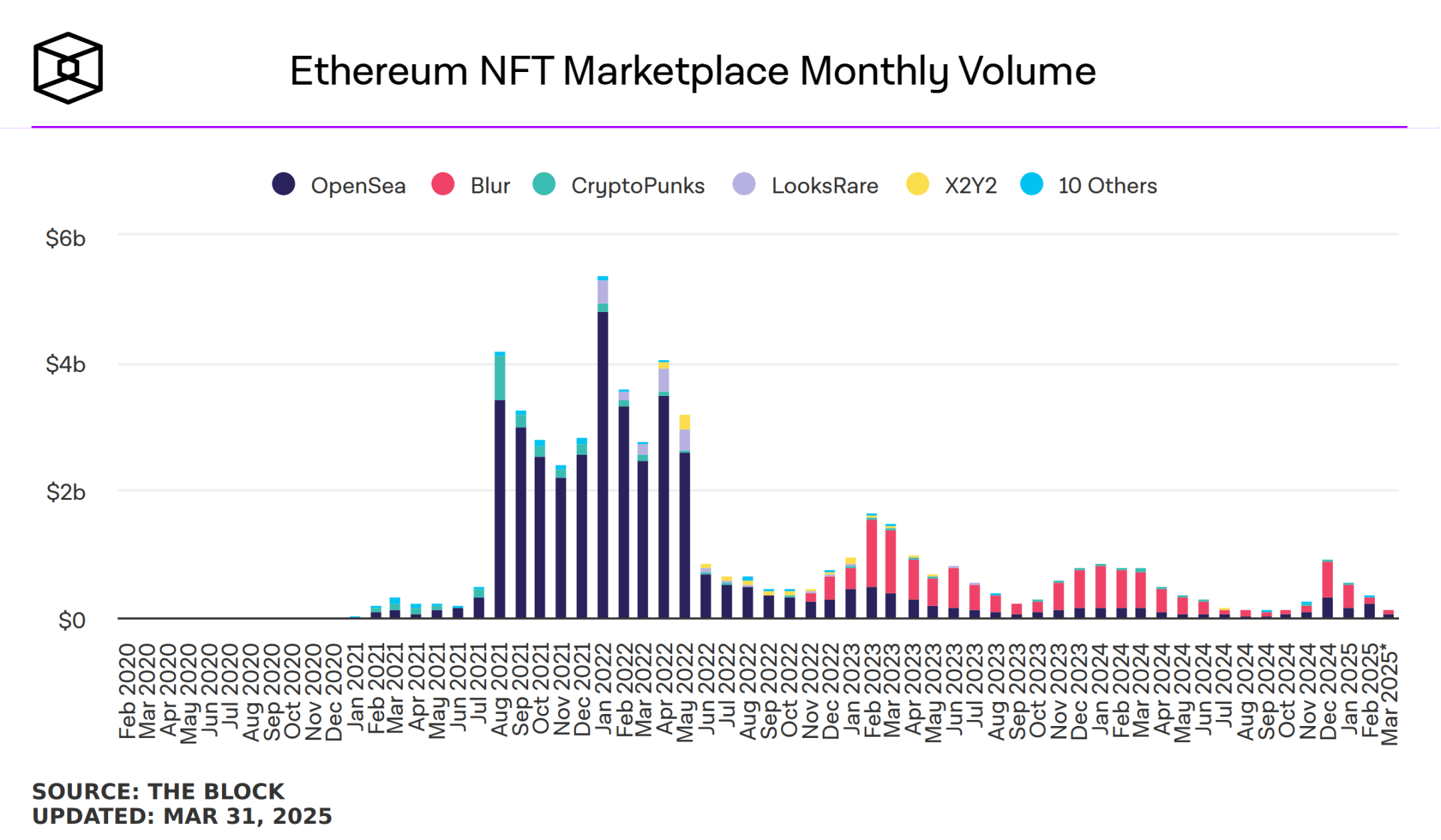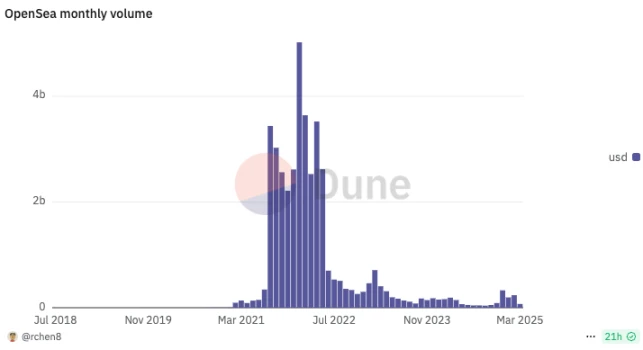Original Author: ChandlerZ, Foresight News
The NFT trading platform X2Y2 announced on March 31 that it will officially cease operations on April 30, 2025. During its three years of operation, the platform recorded a total trading volume of $5.6 billion.
The CEO of X2Y2 pointed out in a statement that the trading volume in the NFT market has decreased by 90% from its peak. He stated, "The life and death of market platforms depend on network effects; it is time to let go and build something with more lasting value."
The team emphasized that this is not a complete farewell but a strategic transformation. Over the past year, they have been exploring the field of AI, with a particular focus on the potential integration of AI and cryptocurrency technology. They plan to develop an AI-driven decentralized platform aimed at continuously creating value rather than merely following market trends.
The CEO admitted that this shift may affect the token price due to the close connection between the X2Y2 token and its NFT business, but he remains optimistic about the long-term value of the team's new direction.
X2Y2 initially attracted a large number of users through low trading fees and a no-royalty strategy, but as market competition intensified, its advantages gradually diminished. In 2023, X2Y2's average market share was 8.79%, having started the year with a relatively high market share, but by the end of the year, its market share had dropped to negligible levels.
The decline of X2Y2 is not an isolated case but a reflection of the overall slump in the NFT industry. According to data from The Block, the monthly trading volume of Ethereum-based NFTs nearly fell to its lowest point in recent years in March due to a general contraction in activity on major platforms. The continued decline in activity on major markets such as OpenSea, Blur, LooksRare, and X2Y2 further confirms that the NFT industry is facing severe challenges.
The Sluggish NFT Market
Between 2021 and 2022, the NFT market rapidly emerged as an important branch of the blockchain industry, becoming a core driving force for the growth of the Ethereum network after DeFi. Driven by active trading, an influx of users, and capital injection, blue-chip NFT projects like OpenSea, CryptoPunks, and BAYC quickly gave rise to a new market valued at over $100 billion. However, since the second half of 2022, NFT trading volume has plummeted, the value of blue-chip projects has significantly shrunk, and the entire sector has fallen into a liquidity crisis.
According to The Block's data dashboard, the monthly trading volume of Ethereum-based NFTs in March nearly reached its lowest level in recent years, dropping to $139 million, a 59.9% decrease from February's $347 million, approaching the lowest trading volume since June 2021.

In 2021, NFT trading volume peaked, exceeding $5 billion in a single month. This period marked the first large-scale breakout of the NFT concept, with high-value projects like CryptoPunks and Bored Ape Yacht Club (BAYC) emerging in large numbers. However, after 2022, the overall market quickly receded, with monthly trading volumes significantly declining, averaging around $1 billion. During the same period, the Blur platform rose rapidly, quickly capturing market share and even briefly surpassing OpenSea, creating a clear competitive landscape.
According to data from Dune Analytics, OpenSea once dominated the NFT market and secured investment opportunities with a valuation of $10 billion. At the beginning of 2022, its trading volume peaked at nearly $5 billion per month, symbolizing the NFT boom.

After 2023, OpenSea's trading volume significantly shrank, with a substantial loss of users and capital, leading to a noticeable decline in market share. The market gradually entered a rational and even overly cold phase. In March, OpenSea's active users decreased by 22% to 165,000.

The Struggling ETH
On March 31, the ETH/BTC ratio fell to 0.02193, the lowest point in five years. Since the beginning of this year, ETH has dropped 39% relative to BTC, marking the first time ETH has underperformed BTC within 12 months after Bitcoin's reward halving.
According to data from Glassnode, the last time ETH performed so poorly against BTC was in the third quarter of 2019, when the ratio fell to 0.0164, with a quarterly decline of 46%. This historic performance once again reveals Ethereum's lack of sufficient endogenous growth momentum to support the stability of its value in the face of market cycle changes.
The decline in the ETH/BTC ratio reflects the deep-seated dilemmas facing Ethereum. DeFi and NFTs once contributed 75% of Ethereum's on-chain activity, and when both cool down simultaneously, there is a lack of new narratives to take over. The collapse of the NFT market and the sharp decline in Ethereum Gas fees directly impacted ETH's intrinsic economic momentum. As the largest source of high-frequency applications on the Ethereum chain, the cooling of the NFT market significantly reduced on-chain trading demand, leading to a decline in Gas fee revenue.
At this point, the economic model that ETH relies on, which promotes network value through high Gas consumption, has clearly hit a bottleneck. With the adjustment of DeFi projects and the evaporation of blue-chip NFT values, the foundational value of ETH is also shaking.
Moreover, the decline in the ETH/BTC ratio is also related to Ethereum's technical path. Although Ethereum's transition to PoS has addressed issues such as energy consumption, it has not fundamentally resolved the key factor affecting Ethereum's price performance: the sustainability of market demand. While Ethereum's successful transition may bring higher efficiency and lower costs to the network in the long run, its short-term impact on ETH prices is minimal, especially in the context of an overall sluggish market environment, where ETH's value performance appears even weaker.
The Future Dilemmas and Breakthroughs for ETH: Exploring New Growth Points
In the face of the current dilemmas, Ethereum urgently needs to find new growth points to restore its leadership in the cryptocurrency space. The negative effects brought by the slowdown of the NFT market are difficult to reverse in the short term, as the decline in network activity, shrinking Gas fee revenue, and a systemic crisis of asset credit have caused Ethereum's economic model to lose balance amid market turbulence.
The continued decline in the ETH/BTC ratio and the loss of market confidence indicate that the Ethereum ecosystem needs new breakthroughs and rebirth after experiencing the collapse of the NFT market. Whether Ethereum can overcome its current dilemmas and regain market favor will require the test of time, and the ability to find breakthroughs in emerging asset classes and blockchain technology innovations will determine ETH's future fate.
免责声明:本文章仅代表作者个人观点,不代表本平台的立场和观点。本文章仅供信息分享,不构成对任何人的任何投资建议。用户与作者之间的任何争议,与本平台无关。如网页中刊载的文章或图片涉及侵权,请提供相关的权利证明和身份证明发送邮件到support@aicoin.com,本平台相关工作人员将会进行核查。




